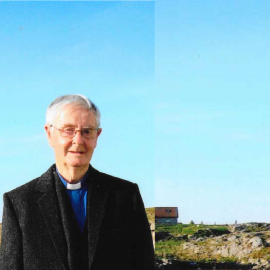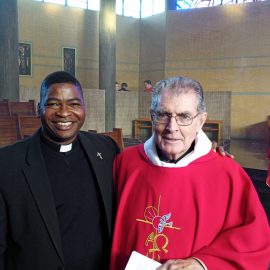A Forgotten Hero

The aftermath of the 1745 Jacobite uprising, which was brutal in its systematic dismantling of the way of life and culture of the Gaeltachd, included the capture of priests, their imprisonment and trial, and their eventual release or banishment.
The actions of the British government in this regard were based on the perception that the uprising was treasonous and that there were connections between the Catholic Church and the uprising itself. Bishop Hugh MacDonald, however reluctantly, had blessed the standard when it was raised in Glenfinnan. Charles Edward Stuart and his companions were dressed in the uniform of students of the Scots College, Paris, when they made landfall at Loch nan Uamh: the Paris College had been a ‘hotbed’ of Jacobite intrigue.
A number of the priests had ‘signed up’ as chaplains to the clan army while others bore arms in support of the cause. Those priests who did support the uprising of 1745 did so largely because of the close family ties which they had with the leaders. Fifteen priests appear on the list of prisoners of the ’45 amongst them four Gordons, two Farquharsons, a MacDonald, a Grant, and a Cameron.
Generally, the priests who were taken prisoner were treated with greater leniency than the non-jurant Episcopalians. Of the eight of these who were taken prisoner two were hanged: the Rev Robert Lyon, Perth, at Penrith on 28th October 1746 and Rev Thomas Coppoch, Manchester, at Carlisle on 18t October 1746; one was tried and acquitted while five were tried, found guilty, and eventually released.
Of the priests taken prisoner, Alexander Cameron SJ died at sea in 1746 and Alexander Gordon SJ died in captivity in May 1746. Bishop Hugh MacDonald was placed on parole. The Farquharsons were banished after trial in May 1747. The others were released between one and two years after being captured, the process ending with Robert Leith who was released on 18th February 1748.
Swept up in the aftermath of the ’45 was Fr Alexander Forrester, the priest of South Uist. He is a most intriguing character whose intent seems to have been solely to look after the pastoral needs of his people. Indeed, it appears that he tried to distance himself from the uprising and all that was involved in it. He even went so far as to take the anti-Jacobite oath. It served him little good as he was arrested in South Uist in 1746 – simply in the wrong place at the wrong time! But it may have been his background which prompted the authorities to deal with him somewhat severely, at least in relation to the others.
Alexander Forrester was one of the heroic figures in the history of the development of the Catholic community on South Uist and yet he has ‘slipped’ from even the popular memory.
He was born in 1701 of Protestant parents, Alexander Forrester and Christina MacKenzie, at a place called Cuil nan Allt in Cromarty in the county of Ross. As a young man he studied law in Edinburgh. While there he came into contact with a group of Catholics and decided to become a Catholic himself. He was received into the Church in Paris in 1726. He became a student for the priesthood and studied at the Scots College, Rome, where he was ordained on 23rd April 1732. On arrival in Scotland, he went to Scalan and was immediately appointed to South Uist where he arrived in November 1732. He established himself at Garradhfluich, Gerinish, the predecessor church to St Michael’s Ardkenneth, under the patronage of MacDonald of Garraghfluich, a tacksman of Clanranald.
In the popular history of the island community his arrival was heralded by a mysterious light that could be seen at night on a little promontory near the north of the South Ford. In fact, Fr Forrester arrived from the north, an unusual direction for a priest to come to Uist.
From Garraghfluich he carried out his ministry to the people of Benbecula, South Uist, and Eriskay – a population of 2,100. He was often the only priest on these islands. Others who came did so intermittently and remained for only a short time. His ministry appears in this period to have been dedicated and uneventful.
On July 5th 1746 Fr Forrester, along with Fr Allan MacDonald of the Glenaladale family, were taken prisoner by Alla MacDonald of Knock. Fr Allan MacDonald, who held the rank of Captain in the Jacobite army, was robbed of sixty guineas by his captors. From Benbecula, the priests were taken to Barra then to Loch Bracadale in Skye. Eventually, they ended up on a prison ship at Tilbury. Both were tried and were banished for life. An English vessel landed them in Holland. Robbed and destitute of everything, they made their way to the Scots College in Paris.
They were looked after in the College but in August 1748 Forrester was making his way back to Scotland. George Innes, the Scottish agent in Paris, wrote: ‘Tuesday last parted Mr Forrester from this to Scotland being to go aboard of a Scotch ship from Havre de Grace to Air. We were forced to give him money here, and not a small amount, considering the difficulties he has had to pass through in such bad times especially for one of his coat, who had been in the Government’s clutches before and is still in danger to be discovered. We consider him to be an excellent subject’.
In September of the same year Fr Forrester is in Edinburgh, operating under the name of Dunbar. But he was eager to get back to South Uist. He arrived there during the next month but found that it was too dangerous to stay because had he been caught as someone under the sentence of perpetual banishment he would have suffered the death penalty. Soldiers were everywhere. He escaped to Ireland but returned to Edinburgh in 1754. In a letter to the Congregation for the Propagation of the Faith, dated 17th July 1754, he recounts the history of his seizure in 1746, of his banishment in 1747, and of his return to Scotland in 1748. He relates that since then he has been pursued twice. He had fled to the hills, had taken shelter in caves. He had made his escape to Ireland and had not attempted to reach the continent because such a journey was too risky. He writes that he is now back in Edinburgh and hopes to return to his mission as soon as possible. It appears that he may have been in Edinburgh for some time prior t the letter being written.
In 1754 he makes his way north and arrives at Enzie. All that he has with him is his oils. Provided with utensils, he then heads west and is in Moidart in 1756 but is still fearful of returning to South Uist. By now his health is suffering and his psychological condition is poor. He is described as ‘extremely timid and cannot bear to be in a country where redcoats reside’.
Sometime before 1760 Alexander Forrester returned to Uist. He is described in a letter of Bishop Hugh MacDonald in that year ‘as an innocent man who has been upwards of thirty years in our trade and is now so infirm by labour, imprisonment, banishment, sickness, and old age that he would never be able for the present purpose for want of health and strength even though he had all the other necessary qualities’.
In 1766 an assistant was appointed to Fr Forrester – Fr Wynne. They were in the thick of MacDonald of Boisdale’s persecution in 1770. Both were ordered to leave the island entirely or he would call in the militia to have them arrested. In 1771 there was a period of peace when Boisdale was in Edinburgh for the winter. But when he returned, the persecution was as bad as ever. Fr Wynne was removed and replaced Fr Alexander MacDonnell.
In 1776 Bishop John MacDonald wrote to Bishop Hay: ‘Mr Forrester, Uist, by an issue in one of his legs, is quite confined and shall probably come to his end by it. But the Bishop was to die first. Fr Forrester cast his vote in favour of his successor as bishop, Alexander MacDonald. He made a visitation of the District in the latter part of 1780. He came to Uist only in time to attend Fr Forrester’s funeral. On 13th January 1781 he wrote to Bishop Hay: ‘When lately in the Long Island (Uist) I had the mortification to be present at worth Fr Forrester’s internment. He made his exit out of this life very much and deservedly regretted, his whole life being uniform and exemplar in the highest degree. He continued upwards of six months before this period very infirm, labouring under several indispositions, and a slight fever of a few days put an end to his life. Fr Alexander MacDonald, Uist, who attended him on his deathbed found no more of all he ever possessed than what was thought necessary for his funeral charges. If any were to remain over and above this he ordered to the poor’.
It is likely that the saintly Fr Alexander Forrester died in December 1780 and is buried at Howmore.
There is a story that during his early years in Uist Fr Forrester received a visit from his sister – the only relative who ever visited him. Having arrived at Gerinish, she called at a certain house and asked to be directed to where a ‘duine, dosgach a chaidh a dhith air Dia’ lived. The head of the house said that he didn’t know of such a man, but would she tell him the name. She replied ‘Alexander Forrester, my brother’. To which the man answered that on the contrary Fr Forrester was a good and holy man, held in great esteem by the people of Uist.
This short article is based on the manuscript notes of Mgr Duncan MacLean and Mgr Roderick MacDonald.



